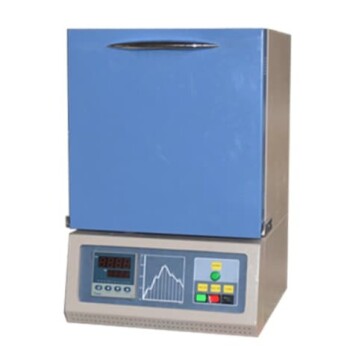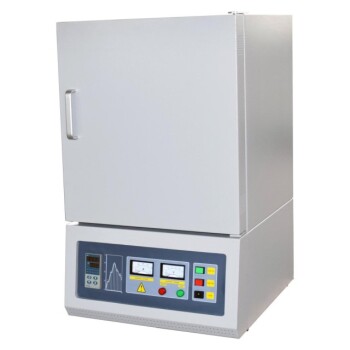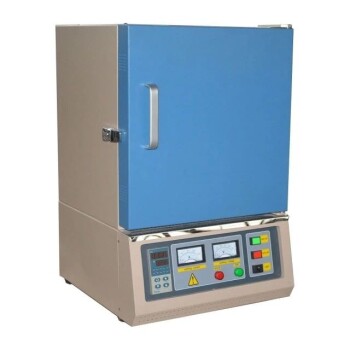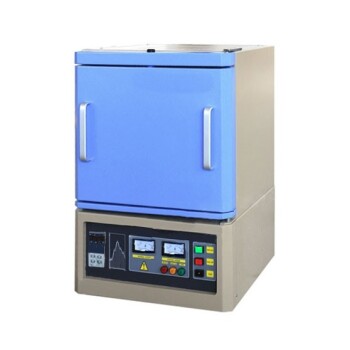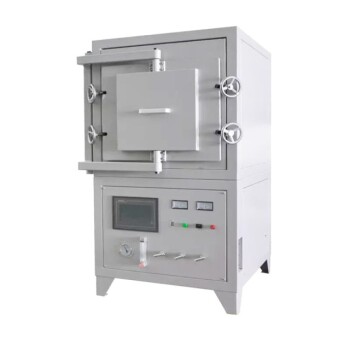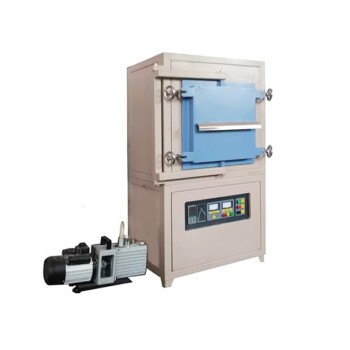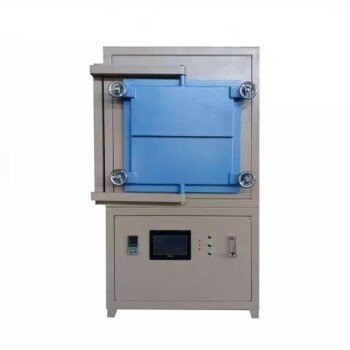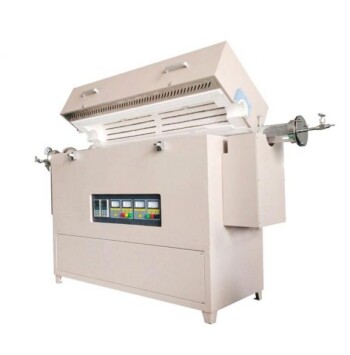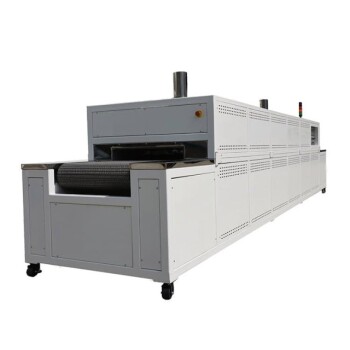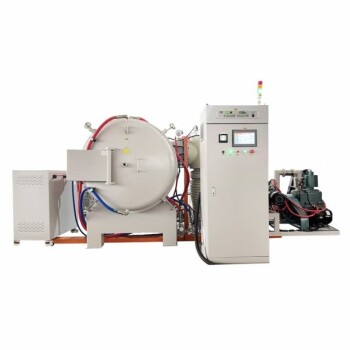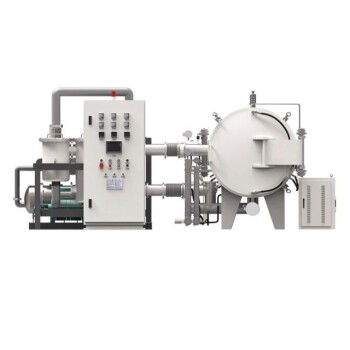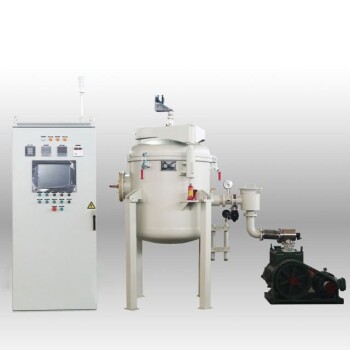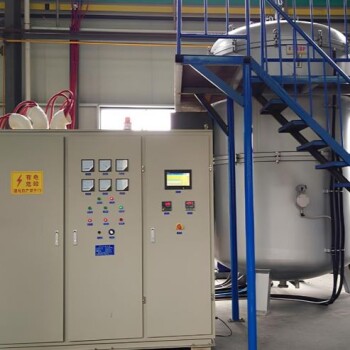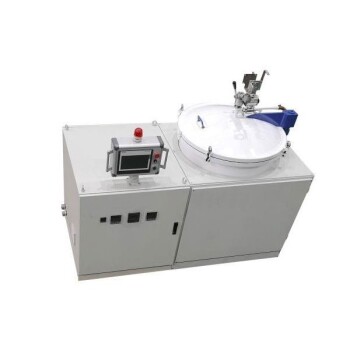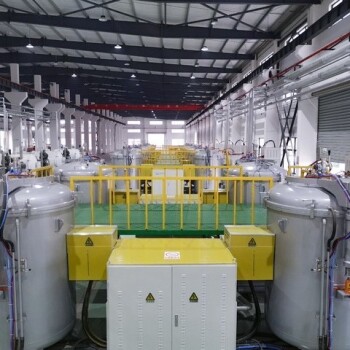マッフル炉の原理と構造
マッフル炉の種類
実験室のマッフル炉には様々なタイプがあり、それぞれ独自の加熱原理と用途によって区別されます。最も一般的なタイプには電気式、マイクロ波式、ガス式マッフル炉があり、それぞれが科学界の特定のニーズに対応しています。
電気式マッフル炉は、材料の成形、溶解、乾燥、加熱などの作業においてその汎用性が高く評価されています。電磁界を利用して材料を加熱する誘導炉とは異なり、電気マッフル炉は固体金属容器内に収容された電気加熱耐火物を使用します。この設計により、マッフル炉はより高い温度と出力密度で運転でき、より厳しい用途に適しています。
箱型高温炉 箱型高温炉はマッフル炉の一種で、多くの場合箱型に似ています。箱型高温炉はマッフル炉の古典的な変種であり、その形状は箱型に似ていることが多い。この扉には保温性を高めるために内扉が装備されることが多く、箱型炉は多くの実験室で採用されています。
サーモリーン・マッフル炉はもう一つの特殊なタイプで、特に工業用卓上炉として知られています。これらの炉は最高 1200°Cに達することができ、工業環境における高温プロセスに理想的です。
これらの異なるタイプのマッフル炉を理解することで、研究者や実験室はそれぞれのニーズに最適な装置を選択することができます。
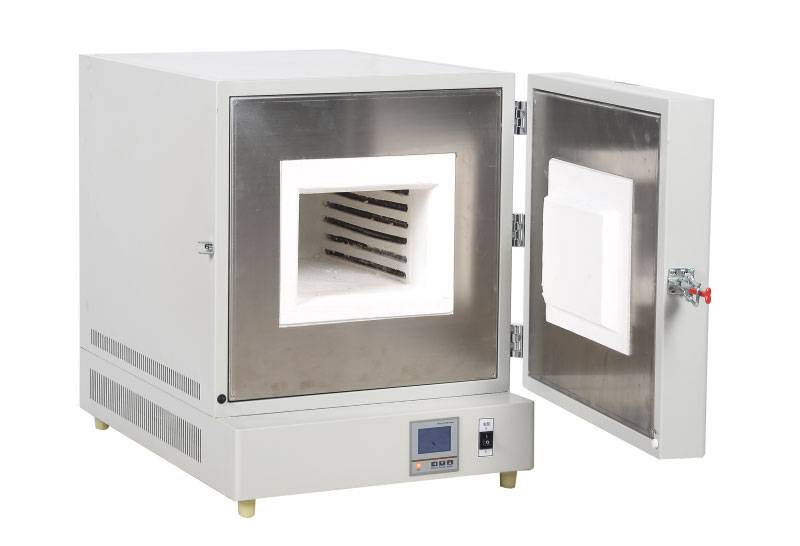
加熱メカニズム
マッフル炉は電気エネルギーを熱エネルギーに変換するために様々な加熱メカニズムを利用します。最も一般的なタイプには電熱マッフル炉とマイクロ波マッフル炉があり、それぞれ異なる方法で熱を発生させます。
電熱式マッフル炉
電熱マッフル炉は以下の方法で熱を発生します。 ジュール加熱 導体に電流を流すと抵抗によって発熱するプロセス。この方法は非常に効率的で、正確な温度制御のために実験室で広く使用されています。一般的にニクロムやカンタルなどの材料で作られた発熱体は、高温に耐えるように設計されており、安定した信頼性の高い発熱を保証します。
マイクロ波マッフル炉
対照的に、マイクロ波マッフル炉は マイクロ波 を利用して電気エネルギーを熱エネルギーに変換します。このプロセスでは、マイクロ波が炉内の材料と相互作用して分子攪拌を引き起こし、急速で均一な加熱につながります。この方法の利点は、材料を迅速かつ均一に加熱できる点にあり、迅速な熱処理を必要とする用途に特に適しています。
どちらの加熱メカニズムも、異なる産業や研究のニーズに応える独自の利点を提供する。これらの原理を理解することは、特定の用途に最適なマッフル炉を選択する上で極めて重要です。
主要コンポーネント
マッフル炉の主要コンポーネントはその機能と効率に不可欠です。主なコンポーネントは以下の通りです:
-
発熱体:炉内で必要な熱を発生させるための重要な部品です。炭化ケイ素や金属合金など様々な材質があり、それぞれ耐久性や耐熱性など独自の特性を備えています。
-
断熱材:高品質の断熱材は炉内温度を維持し、熱損失を防ぐために不可欠です。一般的な材料としては、セラミックファイバーや耐火レンガなどがあり、優れた断熱性と構造的な支持力を発揮します。
-
炉室:実際の加熱プロセスが行われる中核部分。チャンバーは通常、過酷な条件に耐え、均一な加熱を確保するため、高温合金またはセラミックスで作られています。
-
温度制御システム:正確な温度調節には、高度な制御システムが不可欠です。これらのシステムには、デジタルコントローラー、熱電対、PID(比例積分微分)コントローラーなどが含まれることが多く、温度を一定に保ち、加熱プロセスを自動化します。
マッフル炉が効果的かつ効率的に稼動するために、これらのコンポーネントはそれぞれ明確な役割を果たし、工業および研究所の幅広い用途に対応しています。
マッフル炉の研究開発
歴史的発展
マッフル炉の進化は、特に第二次世界大戦後の時代において重要な節目を迎えています。この時期、特に温度制御と自動化に重点を置いた技術の進歩が業界に革命をもたらしました。これらの技術革新の背景には、より精密で効率的な加熱プロセスへのニーズがありました。
重要なブレークスルーのひとつは、高度な温度制御システムの開発だった。これらのシステムにより、加熱温度をより正確に調節できるようになり、さまざまな用途で一貫した結果を確保するために不可欠となった。さらに、オートメーション技術の統合により、手作業の必要性が減り、効率が向上し、人為的ミスのリスクが減少した。
さらに戦後には、マッフル炉の構造設計とエネルギー効率の改善を目指した研究開発が急増しました。その結果、より堅牢で汎用性の高い炉が誕生し、幅広い工業用途や科学用途に適応できるようになった。これらの分野の進歩はマッフル炉の性能を向上させただけでなく、その用途を様々な分野に拡大させた。
まとめると、第二次世界大戦後のマッフル炉開発は、現代の加熱・加工技術を形成する重要な技術革新を特徴とする極めて重要な時期であった。
国内外の研究
中国内外の研究はマッフル炉技術の進歩に大きく貢献してきた。このような努力は主に構造設計、温度均一性、エネルギー効率の3つの主要分野に集中しています。
構造設計 構造設計 構造設計に関しては、国際的な研究により、マッフル炉の耐久性と性能を向上させる革新的な材料と設計が導入された。例えば、高耐熱性セラミックや高度な断熱材の使用により、マッフル炉の全体的な構造的完全性と寿命が向上しています。
温度均一性 は研究のもう一つの焦点であり、特に炉室全体で一貫した加熱を確保することが重要です。この研究により、高度な温度制御システムや、より均等に熱を分布させる改良された発熱体が開発されました。これは、分析化学や材料合成など、精密な温度調節を必要とする用途にとって極めて重要である。
エネルギー効率 も大幅に改善された。研究者たちは、より効率的な加熱メカニズムを開発し、炉部品の断熱を最適化した。例えば、再生熱交換器のような省エネ技術の統合は、エネルギー消費を大幅に削減した。こうした進歩は、操業コストを下げるだけでなく、エネルギーの浪費を最小限に抑えることで、環境の持続可能性にも貢献している。
全体として、国内外の研究者の協力的な努力により、より高度で信頼性が高く効率的なマッフル炉への道が開かれ、幅広い産業および科学的用途に対応している。
注目すべき企業
マッフル炉市場は複数の主要企業によって支配されており、それぞれが業界の技術的進歩や品質基準に大きく貢献している。 カーボライト・ゲロ (英国)は、その高性能マッフル炉で際立っており、様々な研究室環境におけるその精度と信頼性で有名である。同様に ナーバー・サーム (ドイツ)はリーダーとしての地位を確立し、工業用と研究用の両方に対応する幅広いマッフル炉を提供している。
アジア市場では アジア市場では、Zhengzhou Coentec Instrument Co. (Ltd.(中国)は、特に費用対効果に優れ、かつ高品質のマッフル炉ソリューションの開発において大きな進歩を遂げました。これらの企業は最先端の装置を製造するだけでなく、研究開発にも多額の投資を行い、自社製品が技術革新の最前線にあることを保証しています。
| 会社名 | 国名 | 主な貢献 |
|---|---|---|
| カーボライト・ゲロ | 英国 | 高性能精密マッフル炉 |
| ナーバーサーム | ドイツ | 多様な用途に対応する広範なマッフル炉 |
| 鄭州コエンテック | 中国 | コスト効率に優れた高品質のマッフル炉ソリューション |
これらの注目すべき企業は、マッフル炉技術の未来を形成し続け、効率性、耐久性、使いやすさの向上を推進しています。

マッフル炉の用途
工業用途
マッフル炉は様々な産業分野、特に熱処理、ワーク処理、材料合成において重要な役割を果たしています。マッフル炉はセメントや建築材料などの産業において、原材料や最終製品の高温処理を促進するために不可欠な炉です。
セメント産業では、原料の炭酸カルシウムをセメント製造の主要成分である石灰に変えるプロセスである原料の脱炭酸にマッフル炉が使用されます。この熱処理工程は、最終的なセメント製品の品質と一貫性を確保するために不可欠である。同様に、建築材料分野では、セラミック、レンガ、その他の建築材料の熱処理に使用され、その耐久性と構造的完全性を高めています。
さらにマッフル炉は、精密な温度制御と均一な加熱を必要とするセラミックや複合材料などの先端材料の合成に不可欠です。加熱プロセスを環境から隔離しながら高温を維持できるマッフル炉は、このような用途に理想的で、材料が汚染されることなく必要な化学的・物理的変化を受けることを保証します。
まとめると、マッフル炉はセメントや建築材料の工業プロセスに不可欠であり、熱処理や材料合成の品質と効率に大きく貢献しています。
医療および分析化学
マッフル炉は医学および分析化学の分野で極めて重要な役割を果たし、多くの重要な用途に使用されています。マッフル炉は医薬品試料の正確な加熱と処理を促進し、その純度と有効性を保証する医薬品検査プロセスに不可欠です。さらに、マッフル炉は試料の前処理にも利用され、その後の分析手順における試料の前処理に重要なステップとなるため、分析結果の精度と信頼性が向上します。
環境分析では、マッフル炉は水や大気サンプルの分析に使用され、汚染物質や汚染物質の検出に役立ちます。この用途は環境衛生を維持し、規制基準を確実に遵守するために不可欠です。さらに、マッフル炉は油の品質分析にも不可欠で、石油や自動車などの産業にとって極めて重要な油の成分や特性の測定に役立っています。
マッフル炉の多用途性と精度は、こうした分析化学や医化学の用途において非常に貴重なツールとなり、これらの分野の進歩に大きく貢献している。
石炭分析
石炭分析は、石炭の品質と様々な産業用途への適合性を評価する上で重要なプロセスです。この分析では主に、水分、灰分、揮発性物質、元素組成などの主要パラメータの決定に重点を置いています。これらの各パラメータは、さまざまな条件下での石炭の挙動や、工業プロセスにおける全体的な有用性に関する貴重な洞察を提供します。
-
水分:これは石炭に含まれる水分を示すもので、発熱量や取り扱い特性に大きく影響する。高い含水率は燃焼や輸送の非効率につながります。
-
灰分:灰分は石炭の燃焼後に残る不燃性の残渣である。灰分が高いと石炭の熱効率が低下し、灰の処理コストが高くなる。
-
揮発物質:石炭の加熱中に放出される可燃性ガスのこと。揮発分は石炭の着火・燃焼特性に影響を与え、燃焼効率や環境排出に影響を与える。
-
元素分析:石炭中の炭素、水素、窒素、硫黄、酸素などの元素の濃度を測定する。これらの元素は石炭の化学組成と環境への影響を理解する上で重要な役割を果たす。
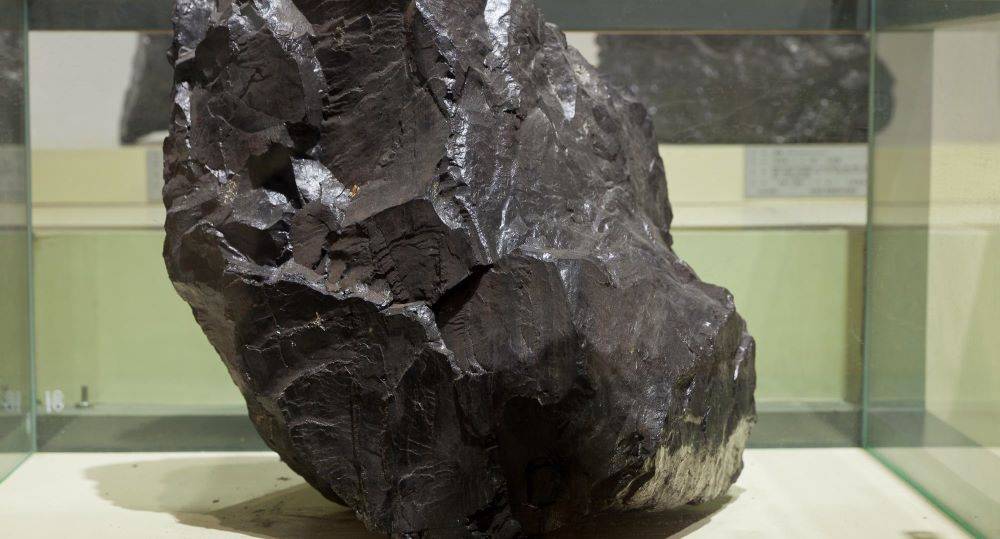
石炭分析におけるマッフル炉の使用は、その正確な温度制御と均一な加熱能力のために最も重要である。これらの炉は正確で再現性のある結果を可能にし、石炭を主要なエネルギー源とする産業にとって不可欠である。
将来の展望
カスタマイズと革新
マッフル炉技術の将来は、個別化、インテリジェント化、省エネルギー化へと大きくシフトしていく。 パーソナライズされた、インテリジェントでエネルギー効率の高いソリューション .このような進歩は単なる漸進的なものではなく、マッフル炉の設計や様々な産業分野での利用方法におけるパラダイムシフトを意味します。
パーソナライズされたソリューション
パーソナライゼーションは重要な推進力となり、マッフル炉を様々な分野特有の要求に合わせることを可能にする。例えば医療分野では、医薬品検査や試料前処理に不可欠な、正確な温度制御と最小限のコンタミのために炉が最適化されるかもしれない。一方、工業分野では高スループットや過酷な条件にも対応できる堅牢な設計が要求されます。
インテリジェントな自動化
マッフル炉のインテリジェント化は、高度な自動化技術とAI技術を活用した、もう一つの重要なトレンドとなる。これらのインテリジェント・システムは、予知保全、リアルタイム・モニタリング、適応制御メカニズムなどの機能を提供する。例えば、AI駆動型マッフル炉は、処理される材料に基づいて加熱プロフィールを自律的に調整し、最適な結果を保証してエネルギーの無駄を最小限に抑えることができる。
エネルギー効率
エネルギー効率は、特に環境問題への懸念と規制圧力の高まりに照らして、引き続き重要な焦点である。将来のマッフル炉には最先端の断熱材と発熱体が組み込まれ、性能を損なうことなくエネルギー消費量を削減します。熱管理および廃熱回収システムの革新により、マッフル炉の環境適合性はさらに高まります。
まとめると、マッフル炉の未来は、カスタマイズ、インテリジェンス、エネルギー効率の融合によって特徴付けられ、世界中の産業界の多様で進化するニーズに対応することになる。
ユーザー・エクスペリエンスの向上
マッフル炉技術におけるユーザー・エクスペリエンスの向上には、安全性、操作効率、分析機器とのシームレスな統合を優先する多面的なアプローチが含まれる。これらの機能強化は、性能を最適化するだけでなく、装置をより使いやすく、さまざまな産業界のニーズに適応できるように設計されています。
安全性の強化
実験室や工業環境において、安全性は依然として最重要課題です。最新のマッフル炉には、自動シャットオフ機能、リアルタイムの温度モニタリング、熱事故のリスクを最小限に抑える堅牢な断熱材など、高度な安全機構が装備されています。これらの機能により、ユーザーは安全が最優先されることを認識しながら安心して炉を操作することができます。
運転効率
効率性の向上は、エネルギー消費量の削減と加熱プロセスのスピードと精度の向上に重点を置いています。スマート温度制御システムやエネルギー効率の高いヒーターエレメントなどの技術革新により、加熱サイクルの迅速化と温度調節の精度が向上します。これにより、時間の節約だけでなく運転コストも削減され、マッフル炉の経済性が向上します。
加熱の均一性
炉室全体で均一な加熱を実現することは、材料処理や分析で一貫した結果を得るために極めて重要です。新しい設計には、均一な熱分布を確保し、ホットスポットやコールドスポットを排除する高度な熱分布システムが組み込まれています。この均一性は、精密な温度制御が必要なアニール、焼結、化学反応などの作業に不可欠です。
分析機器との統合
マッフル炉を分析機器と統合することで、科学研究および産業用途での有用性が高まります。例えば、スペクトロメーター、クロマトグラフ、その他の分析機器とのインターフェースにより、リアルタイムのデータ収集と分析が可能になります。この統合によってワークフローが合理化され、研究者や技術者に即座に分析できる包括的なデータセットが提供されるため、実験や技術革新のペースが加速される。
マッフル炉のユーザー・エクスペリエンスは、このような重要な分野に焦点を当てることで、大幅に向上し、様々な業界において、より汎用性が高く、信頼性が高く、効率的なツールとなります。

